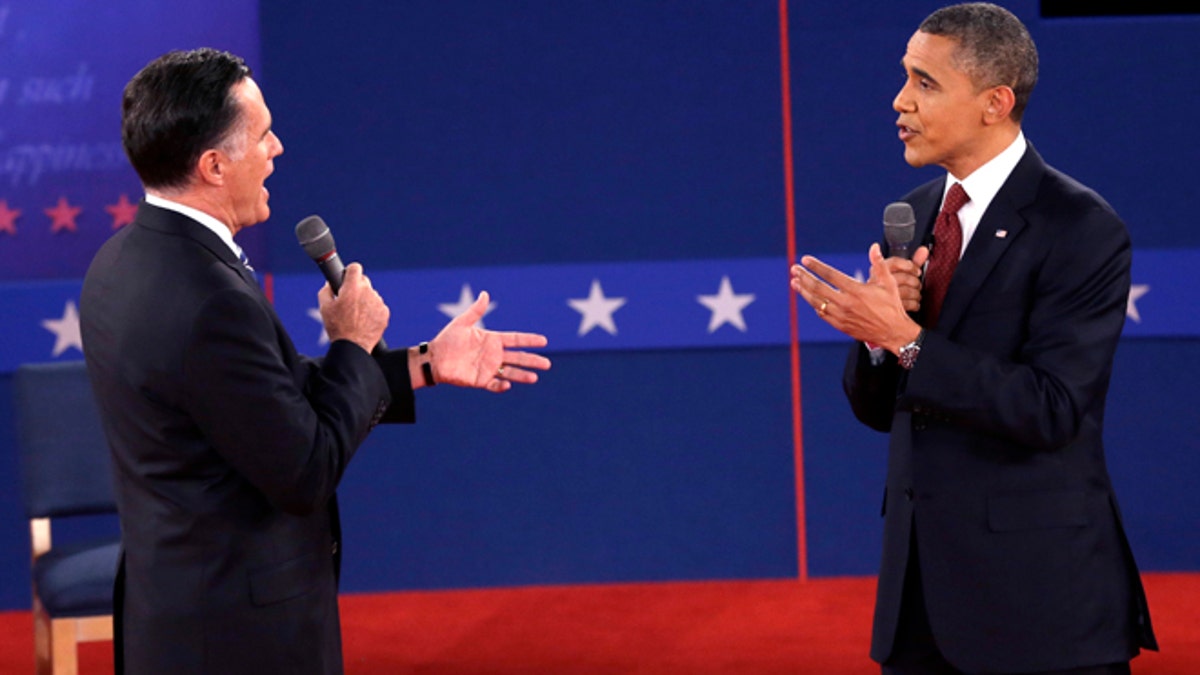
Oct. 16, 2012: Republican presidential nominee Mitt Romney and President Barack Obama speak during the second presidential debate. (AP)
Romney’s biggest missed opportunity in the second debate wasn’t on Libya – he’ll get to address that in depth in the third debate. It was on the question about how he would differ from Bush administration economic policies. It was a missed opportunity because he should have connected the dots between Obama and Bush to illustrate the accurate point that on the most significant dimensions of economic policy, Obama has accelerated Bush’s policy errors rather than reversing them.
In the crucible of the 2008 financial crisis, President Bush famously remarked that “I chucked aside my free-market principles .” He was referring to TARP, his infamous big bank bailout. Obama supported the bill and voted for it.
Even before the TARP bill gave legal legitimacy to bank bailouts, the Federal Reserve was already conducting extraordinary operations well beyond its normal monetary policy purview, in a series of backroom deals negotiating principally in the office of the New York Fed, then led by Timothy Geithner.
So nothing signaled a continuation of Bush-era policies more clearly than Obama’s decision to promote Geithner to Treasury Secretary, his point man on economic issues. The message wasn’t lost on Wall Street special interests, who the New York Times reported refer to Geithner as “our man in Washington.”
During the Dodd-Frank fight, Obama pretended to be ending bailouts, but the truth was he was virtually guaranteeing them. In a report on the repeated bailouts of Citigroup, the special inspector general for TARP reported that Secretary Timothy Geithner admitted bailouts are still part of the plan, saying: “In the future we may have to do exceptional things again if the shock to the financial system is sufficiently large.”
On government spending, it’s the same story. Bush racked up one of the most disastrous records of out-of-control spending and debt the country had ever seen. Every aspect of the federal budget jumped under Bush. Economist Veronique de Rugy of the Mercatus Center found that in Bush’s second term, he nearly doubled total federal spending. Moreover, she found that spending on subsidy programs – big government interventions in the market to pick winners and losers that have been a central theme of Obama’s agenda – jumped 30 percent under Bush and included over 1,800 separate programs.
Art Laffer and Stephen Moore summarized the orgy of government spending at the end of the Bush administration: “From the second quarter of 2007, i.e., the first full quarter of a Pelosi-Reid dominated Congress and a politically weakened President Bush, to the second quarter of 2009 when President Obama assumed office, government spending skyrocketed to 27.3% of GDP from 21.4%. It was the largest peacetime expansion of government spending in U.S. history.”
Obama came in and continued spending recklessly. Bush’s $152 billion stimulus bill failed and so did Obama’s $821 billion stimulus bill. Bush flushed $25 billion in bailout funds to Chrysler and General Motors, and Obama added another $20 billion before finally recognizing that the companies would inevitably file for bankruptcy. All of the pre-bankruptcy bailout dollars were lost. Obama’s health care law will add trillions more to federal spending, and if reelected he plans astonishing spending increases that would make Bush’s profligacy appear amateur; Obama’s never-balancing budget anticipates spending jumping to 30 percent of the economy by 2027, 40 percent by 2040, 50 percent by 2060, and 80 percent by 2080.
Bush’s final deficit of $458 billion in 2008 – nearly half a trillion dollars – was then the largest in American history. Obama has run trillion-dollar-plus deficits in each of his four years.
Most egregious of all, Obama kept Ben Bernanke at the helm of the Federal Reserve, piloting an adventurist monetary policy that has tried to micromanage the economy. Artificially low interest rates are robbing savers and investors of returns, encouraging imprudent risk-taking and rewarding big banks for sitting on huge reserve balances instead of making loans. The Fed’s outsized bond purchases have propped up the failed government-sponsored enterprises Fannie Mae and Freddie Mac, and have enabled Congress and President Obama to rack up their trillion dollar deficits without being disciplined by bond markets. Now, with QE3, we can expect open-ended money creation for the foreseeable future, creating new asset bubbles and punishing thrift and capital creation.
On the biggest economic policy questions, the Bush/Geithner/Bernanke approach is almost indistinguishable from the Obama/Geithner/Bernanke approach. It hasn’t worked. Obama’s failed policies of the present are all too similar to Bush’s failed policies of the past. It’s time to try something different.
